Physical Address
304 North Cardinal St.
Dorchester Center, MA 02124
Physical Address
304 North Cardinal St.
Dorchester Center, MA 02124
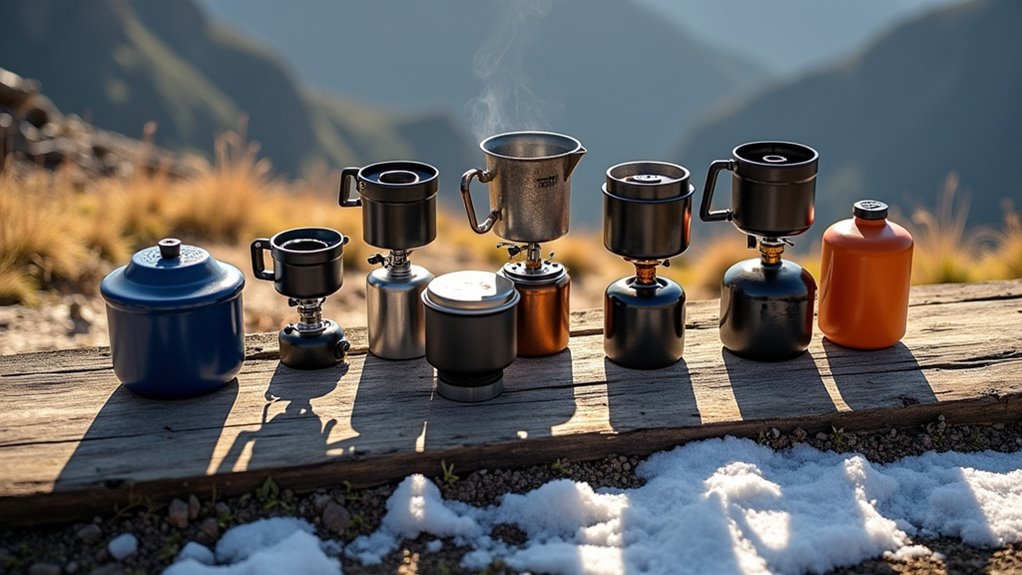
Just when you thought choosing a backpacking stove was simple, these 8 crucial factors will transform your outdoor cooking decisions.
When you’re in the market for a backpacking stove, you’ll find dozens of options that can make your head spin. From ultralight canister stoves to multi-fuel powerhouses, each model offers distinct advantages and limitations. While price tags might catch your eye first, there’s much more to evaluate before making your investment. Let’s explore the eight critical factors that’ll help you choose a stove that perfectly matches your outdoor cooking needs.
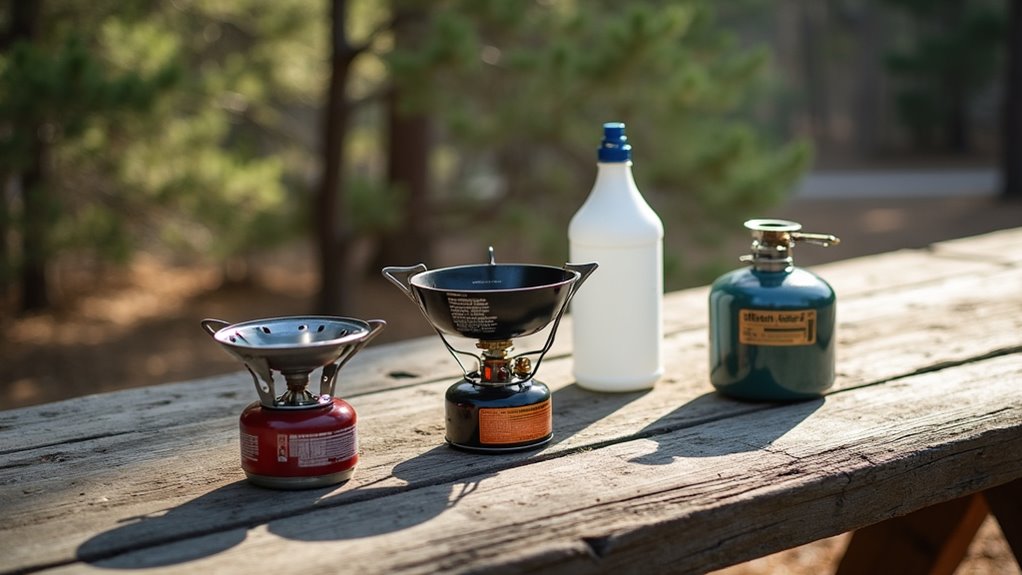
When choosing a backpacking stove, your fuel options will largely determine your cooking experience and trip logistics.
Gas canisters containing butane, isobutane, and propane blends are widely available at outdoor stores and offer convenient, clean-burning fuel. While they’re easy to use, they don’t perform well in cold weather. These canisters can maintain fuel potency for years when properly stored. Proper stove maintenance is crucial for reliable performance.
Gas canisters provide convenient, clean-burning fuel for backpacking stoves but struggle to perform effectively in colder temperatures.
Liquid fuels like white gas and kerosene give you more flexibility and better cold-weather performance, but you’ll need to prime the stove and perform regular maintenance. You’ll find these fuels at camping stores and auto shops, though availability varies internationally.
If you’re traveling by air, check regulations as some liquid fuels face transport restrictions.
Solid fuel tablets are ultralight and compact but cook slower and might be harder to find. Essential camping gear should include a variety of fuel options for your backpacking stove.
Consider your destination’s fuel availability and resupply options before committing to a specific stove type.
How well a stove performs directly impacts your backcountry cooking experience. You should think about boil times, simmer control, and wind resistance when choosing your stove. Integrated canister stoves offer the fastest boil times at 2-3 minutes per liter, while wood-burning and alcohol stoves take considerably longer. The Soto Windmaster stove delivers exceptional performance with its fast boiling capabilities and notable stability.
Don’t overlook stability – wider bases and sturdy pot supports create safer cooking setups. Essential camping gear can make a significant difference in your overall outdoor experience.
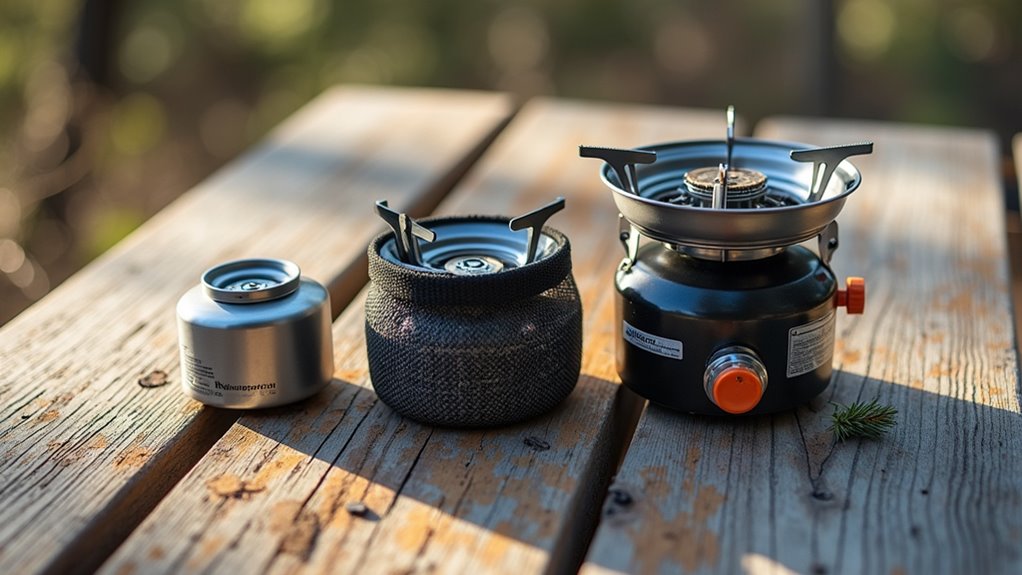
Two critical factors that’ll impact your backpacking experience are stove weight and packability. When choosing a stove, you’ll need to balance total weight against your trip duration.
For weekend trips, alcohol stoves often prove lightest, weighing around 14 ounces with fuel. However, on longer journeys, canister stoves might be more practical despite their higher initial weight. Backpackers can expect integrated cooking systems to provide better fuel efficiency compared to standard setups.
Consider how your stove fits into your pack. Pocket-sized options and upright canister stoves offer excellent portability, with some weighing as little as 3.25 ounces.
Look for stove-pot combinations that nest together to save space. While titanium models provide durability with minimal weight, they’re typically more expensive.
Don’t forget to factor in fuel weight – even small amounts add up, especially on extended trips.
Beyond weight and size assessments, your stove’s performance will vary dramatically based on weather and environmental conditions.
Environmental conditions like wind, altitude, and temperature significantly impact stove performance, making these factors crucial when selecting outdoor cooking gear.
You’ll need to match your stove choice to the environments you’ll encounter most often, as temperature, wind, and altitude all affect cooking efficiency. Liquid fuel stoves burn cleaner and hotter than other options in challenging conditions.
Key environmental factors to take into account:
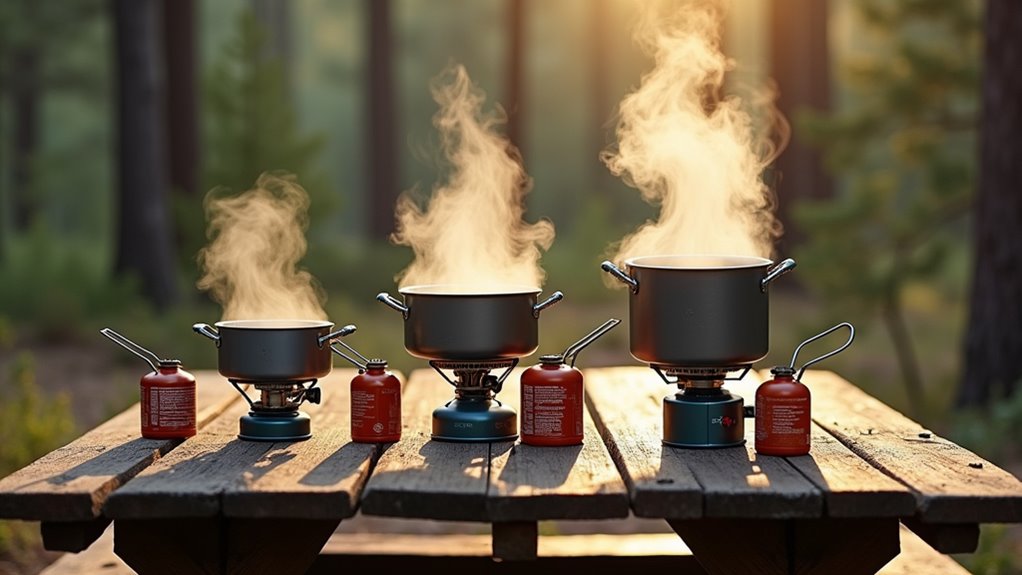
The success of your backcountry cooking setup depends heavily on your group size and trip length. For groups larger than 5-6 people, you’ll need multiple pots or a larger cooking system, like a 4.5L Trangia pot, along with a more powerful stove to reduce cooking time. Consider using .75-1L per person when determining your pot capacity needs.
When planning longer trips, prioritize stoves that are durable, require minimal maintenance, and use readily available fuel. You should strive to balance weight considerations with fuel efficiency, as longer journeys demand more fuel. Essential tips for a memorable family camping trip can help ensure your backcountry adventure is a success.
Look for stoves that offer both simmering and rapid boiling capabilities to accommodate various meal types.
Consider your budget for both initial purchase and ongoing fuel costs. While premium stoves might cost more upfront, they often provide better long-term value through improved durability and fuel efficiency.
When selecting a backpacking stove, boil time and fuel efficiency work hand in hand to determine your cooking experience and ongoing costs. While faster boil times might seem appealing, they’re not always the most fuel-efficient option, especially in challenging conditions like high altitudes or windy weather. Portable options are increasingly popular due to their blend of performance and convenience.
Consider these key performance factors:
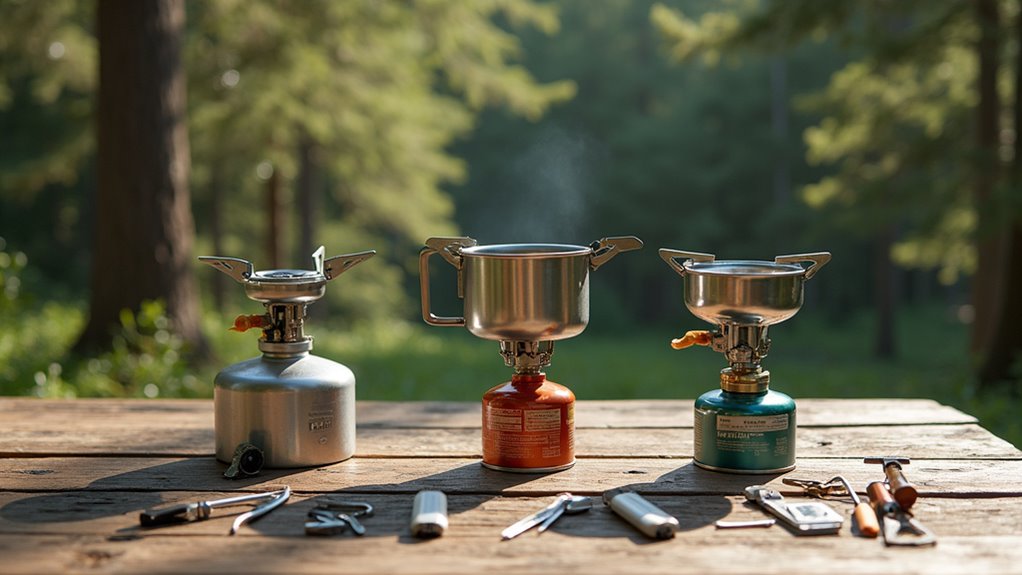
While backpacking stoves offer varying levels of sophistication, choosing one that’s easy to use and maintain can greatly impact your outdoor experience.
Look for lightweight models under 10 ounces with nested components to simplify packing and transportation. Stoves with integrated piezo ignition and quick-release fuel connections will save you time during setup. Canister stoves with few moving parts require minimal maintenance and are ideal for beginners.
To guarantee longevity, you’ll need to clean your stove regularly. Essential items for your next camping adventure can help ensure your stove remains in top condition.
Choose models with self-cleaning features or easily accessible parts that you can maintain without special tools. Before long trips, empty fuel bottles and store your stove in a dry, ventilated space.
If possible, select a stove with modular design and readily available replacement parts. This makes field repairs simpler and extends your stove’s lifespan, saving you money in the long run.
Making smart choices about maintenance goes hand-in-hand with understanding stove costs and value.
When you’re shopping for a backpacking stove, you’ll find options ranging from budget-friendly $17 models to premium systems around $200. Your choice should align with your specific needs and frequency of use.
The MSR WindBurner stands out in harsh conditions with its superior wind resistance and exceptional heat transfer capabilities. Essential camping gear is also an important factor to consider when selecting a backpacking stove.
Consider these key value factors:
Don’t put all your eggs in one basket when selecting a backpacking stove. You should aim to weigh all eight factors carefully, from fuel type to value assessment. Consider your specific needs, trip conditions, and budget constraints. Take time to research and compare different models, and you’ll find the perfect stove that balances performance, portability, and price for your outdoor adventures.